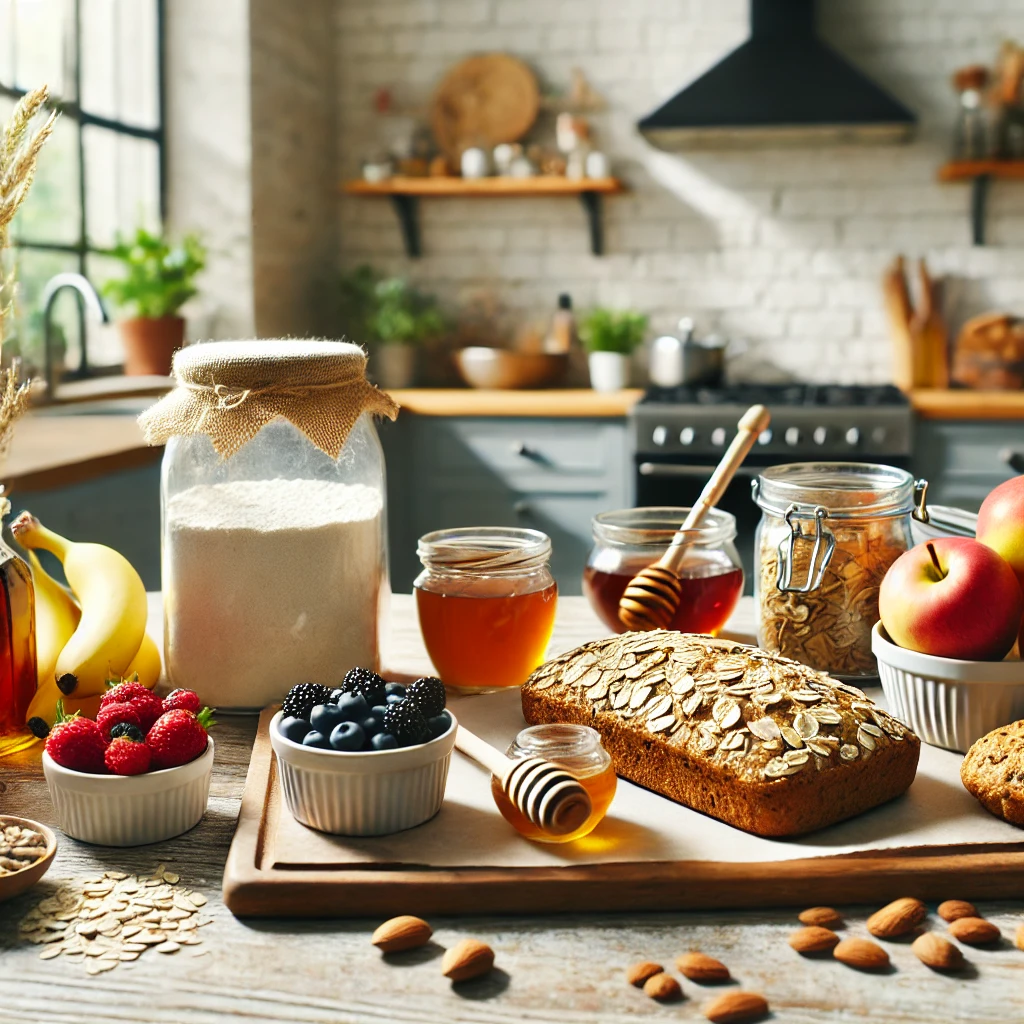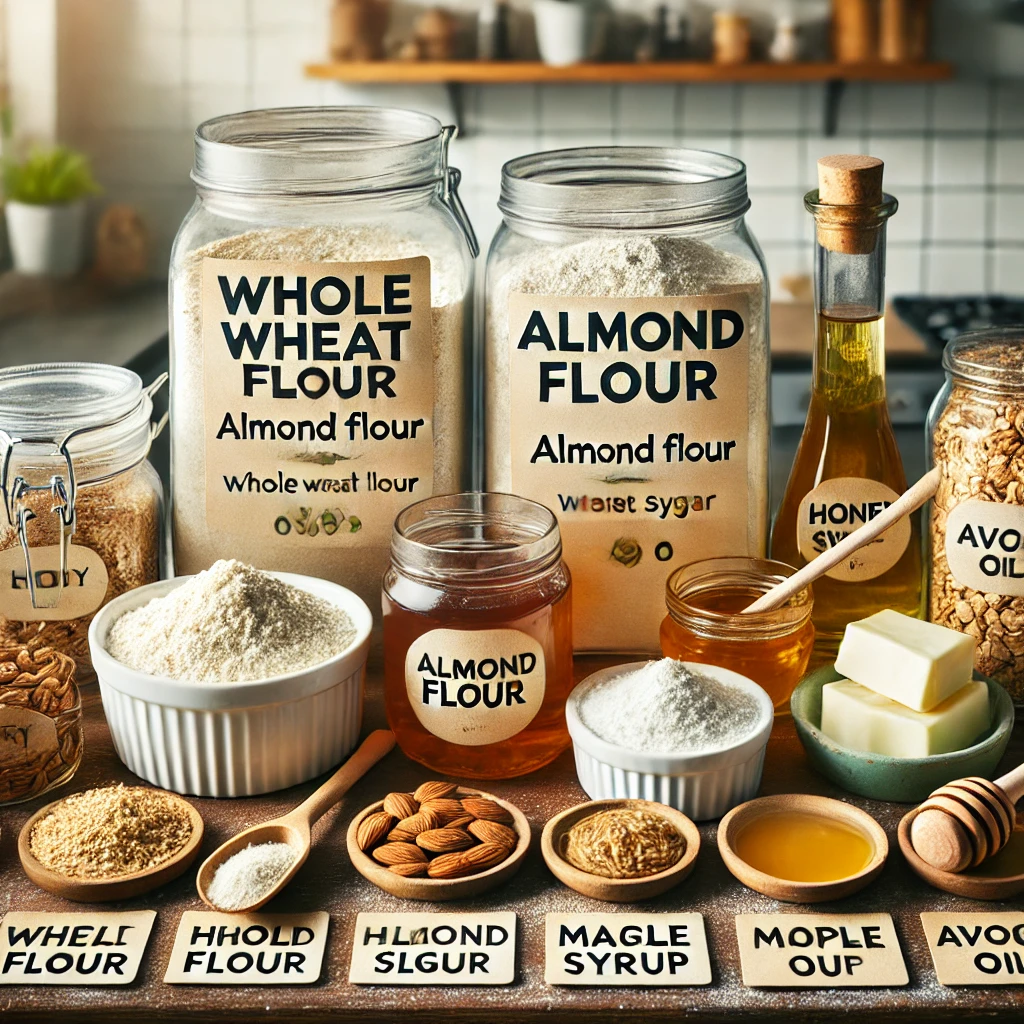Baking is often linked to indulgence—rich cakes, sweet cookies, and flaky pastries. But what if you could enjoy baking while making healthier choices? Healthy baking proves that flavor and nutrition can coexist. By balancing taste and wholesome ingredients, you can create treats that are both delicious and nourishing. With a few simple swaps and techniques, classic recipes become healthier without sacrificing taste
This article covers the benefits of healthy baking, key ingredient swaps, and tasty recipes to try at home. Whether you’re a beginner or switching to healthier baking, this guide helps you bake delicious treats without losing flavor.
Why Healthy Baking Recipes Are Important for Your Health
The Importance of Balanced Nutrition in Everyday Meals
Nutrition is key to a healthy body and mind. Baking doesn’t have to be unhealthy. Using whole grains, natural sweeteners, and healthy fats, you can make baked goods that support a balanced diet. Healthy baking ensures your treats are not only delicious but also fuel your energy levels and provide essential nutrients.
How Baking at Home Gives Control Over Ingredients and Portion Sizes
When you bake at home, you have complete control over what goes into your recipes. This lets you skip additives, preservatives, and excess sugar or unhealthy fats found in store-bought baked goods. Additionally, baking your own treats allows you to manage portion sizes, reducing the likelihood of overindulging. Home baking lets you customize recipes to fit your diet, whether gluten-free, vegan, or low-sugar.
Benefits of Using Nutrient-Rich Ingredients
Healthy baking revolves around selecting nutrient-dense ingredients that enhance the nutritional profile of your recipes. Almond and oat flour add fiber and minerals, while honey and maple syrup provide natural sweetness. Nuts, seeds, and fruits enhance vitamins, antioxidants, and healthy fats, making your baked goods both nutritious and delicious.

The Science Behind Healthy Baking Recipes
Healthy baking goes beyond ingredient swaps—it’s about knowing how these alternatives affect the baking process.Here’s a closer look at the science:
Why Whole Grain Flours Work Differently
Whole grain flours retain the bran and germ, which add fiber and nutrients but also change the texture of baked goods. They absorb more liquid, so recipes often require adjustments to maintain moisture and softness.
The Role of Natural Sweeteners
Natural sweeteners like honey or maple syrup not only add sweetness but also interact differently with other ingredients. They provide moisture, enhance browning, and add depth to flavors, making them ideal for healthier baked goods.
Replacing Fats Without Losing Texture
Traditional fats like butter contribute to the flakiness and richness of baked goods. Substitutes like Greek yogurt or avocado oil replicate these properties while reducing saturated fat content.
Key Ingredient Swaps for Healthy Baking Recipes
Replacing Refined Flour with Whole Grain Options
Refined flour may give baked goods a light and fluffy texture, but it’s stripped of nutrients during processing. Consider using whole wheat flour, almond flour, or oat flour instead. These alternatives not only add fiber but also bring unique flavors and textures to your recipes. For example, almond flour lends a nutty flavor and moist texture, making it perfect for cookies and cakes.
Using Natural Sweeteners Instead of Refined Sugar
Sugar is often the main culprit in unhealthy baked goods. Replace refined sugar with natural options like honey, maple syrup, or stevia. These sweeteners not only reduce the glycemic impact but also add depth to the flavor of your recipes. For instance, maple syrup’s rich, caramel-like taste pairs wonderfully with muffins and bread.
Substituting Unhealthy Fats with Healthier Alternatives
Butter and hydrogenated oils can be replaced with healthier fats such as avocado oil, unsweetened applesauce, or Greek yogurt. These swaps reduce saturated fat content while maintaining the desired texture in your baked goods. For example, applesauce works well in cakes and muffins, keeping them moist and tender.

Tools and Equipment for Healthy Baking
The right tools can make your healthy baking journey more enjoyable and efficient. Consider adding these essentials to your kitchen:
Measuring Tools
Accurate measurements are key in healthy baking, especially when working with alternative flours and sweeteners. Invest in a digital kitchen scale, measuring cups, and spoons for precision.
Mixing and Baking Tools
Silicone spatulas, mixing bowls, and a sturdy whisk or stand mixer are must-haves. Non-stick bakeware or silicone mats reduce the need for added fats or oils.
Gadgets for Special Ingredients
A food processor or high-speed blender can help you make oat flour, nut butter, or date paste at home. These gadgets expand your healthy baking possibilities.

Delicious and Easy Healthy Baking Recipes to Try
1. Guilt-Free Chocolate Chip Cookies
These cookies are a healthier twist on a classic favorite. Made with almond flour, coconut sugar, and dark chocolate chips, they are rich in healthy fats and antioxidants.
2. Low-Sugar Banana Bread
This moist and delicious banana bread is sweetened naturally with ripe bananas and honey. Whole wheat flour and walnuts make it a nutritious snack or breakfast option.
3. Vegan Blueberry Muffins
These fluffy muffins use oat flour, chia seeds, and almond milk, making them vegan-friendly and rich in fiber. The blueberries add a burst of sweetness and antioxidants.
Healthy Baking Recipes for Gluten-Free, Vegan, and Low-Carb Diets
Whether you’re gluten-free, vegan, or low-carb, healthy baking can cater to your dietary preferences. Here’s how:
Gluten-Free Baking
Use almond flour, coconut flour, or gluten-free all-purpose blends. Xanthan gum or psyllium husk can help replicate the elasticity of gluten.
Vegan Baking
Replace eggs with flax eggs (1 tablespoon ground flaxseed + 3 tablespoons water) or chia eggs. Use plant-based milk and dairy-free butter for creamy textures.
Low-Carb Baking
Opt for almond flour or coconut flour as low-carb alternatives. Sweeten with stevia, erythritol, or monk fruit for a keto-friendly twist.
The Profitability and Essentials of Coconut Farming
Coconut farming in the word plays a vital role in agriculture, with vast coconut plantations contributing to the economy and livelihood of many farmers. Successful coconut cultivation depends on factors like proper coconut planting distance, soil quality, and the right coconut tree fertilizer to ensure healthy growth. A well-maintained coconut farm requires sustainable practices, including selecting the best coconut fertilizer to boost yield. Many wonder, is coconut farming profitable in India? The answer depends on efficient farm management, market demand, and innovative techniques. With proper care, a coconut tree farm can thrive, making coconut agriculture a rewarding investment.
Common Mistakes in Healthy Baking (And How to Avoid Them
Mistake 1: Overmixing Batter
Overmixing can lead to dense or tough baked goods, especially with whole grain or alternative flours. Mix just until combined.
Mistake 2: Misjudging Sweetness Levels
Natural sweeteners often taste less sweet than sugar. Start with small quantities and adjust to your preference.
Mistake 3: Ignoring Leavening Adjustments
Alternative flours can be heavier, requiring additional leavening agents like baking soda or powder to achieve the right rise.
Creative Toppings and Add-Ins for Healthy Baked Goods
Nutritious Toppings
Add texture and nutrients with toppings like almond butter, granola, or toasted coconut.
Superfood Boosters
Incorporate cacao nibs, hemp seeds, or goji berries for added antioxidants and vitamins.
Fruits and Seeds
Fresh or dried fruits and seeds like pumpkin or sunflower seeds enhance flavor while boosting fiber and nutrients.
How to Store Healthy Baked Goods
Preserve Freshness
Store baked goods in airtight containers to retain moisture. Use parchment paper to separate layers of cookies or bars.
Freeze for Longevity
Freeze muffins, bread, or cookies in individual portions. Defrost at room temperature or reheat in the oven for fresh-tasting treats.
Consider Natural Ingredients
Healthy ingredients like fruits and natural sweeteners can shorten shelf life. Consume quickly or store properly to avoid spoilage.
The Long-Term Benefits of Healthy Baking
Supports Overall Wellness
Healthy baking contributes to balanced energy levels, improved digestion, and better weight management.
Promotes Family Bonding
Baking as a family is a great way to instill healthy eating habits while enjoying quality time together.
Cost-Effective and Nutritious
Homemade baked goods save money and allow you to customize recipes to your dietary needs.
Conclusion
Healthy baking is more than a trend—it’s a lifestyle shift that combines flavor and nutrition. With the right tools, ingredients, and tips, you can transform your favorite baked goods into wholesome, nourishing treats. Start experimenting with these recipes and share your healthy baking successes in the comments below. Let’s inspire a community of health-conscious bakers!


2 thoughts on “Healthy Baking Recipes: Balance Flavor & Nutrition”